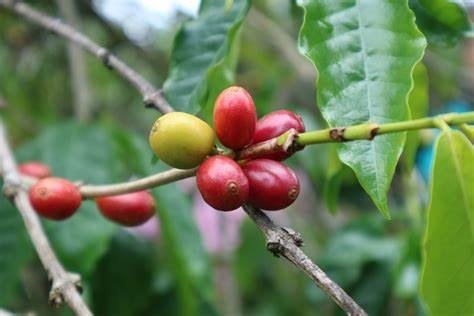TRADITIONAL COFFEE PROCESSING IN OUR VILLAGE
Hi Hivers wherever you are, I hope you are fine and healthy....
Drinking coffee is a hobby in our area, including I am also a coffee lover, for me there is no day without drinking coffee. Drinking coffee accompanied by snacks will add pleasure to me

On this occasion I will tell you about the traditional coffee processing process in our village. There are several types of coffee in our village, but most are local Javanese coffee. Coffee that is ready for harvest has the characteristics that the fruit looks dark green and the flesh is hard, usually the farmers before picking will make sure the coffee is ready to be harvested or not. A feature that is obvious when the coffee is red, however, it is not uncommon for farmers to pick coffee that is still green as long as it is old (hard seeds).

After being picked, the coffee is pounded using a traditional tool called a "mortar" and "pestle".

Mortar and pestle are a pair of traditional kitchen tools which are still commonly found in Javanese society. In the beginning, the existence of this mortar-pest kitchen tool was mostly used to pound paddy into rice, but gradually its function changed to pounding rice into flour, coffee and others. Kitchen utensils that are hundreds of years old are also used by other tribes in Indonesia. In general, a pestle is made of wood, such as teak, jackfruit wood, or other types of strong wood, while a mortar is made of wood, stone or iron. A wooden or stone mortar pairs well with a wooden pestle. While the iron mortar, usually the pestle is also made of iron. It's just that the iron mortar and pestle is smaller in size. Below is the process of grinding coffee beans using a mortar and pestle

The purpose of the pounding is to separate the coffee beans from their skins before drying. There is also wet coffee that is directly dried in the sun without going through the crushing process first, but if the coffee is directly dried in the sun without being pounded, the drying time will take longer. Below is a picture of coffee beans that are ready to be dried in the sun (dried).

Drying is done under the hot sun so that the coffee beans dry, if the weather is good the drying process takes about 4 to 7 days.

The dried coffee is then pounded again so that the coffee beans are completely peeled from the skin.

The next step is to remove the coffee beans from their skins, then pick them up again so that the coffee beans are completely dry. The purpose of drying is to make coffee durable and long lasting if stored.

The dry coffee is then roasted using a stove until it turns brown in color.

After the roasting process is complete, the next stage is pounding, the coffee beans are ground using a "mortar and pestle" until smooth.

So that the coffee beans are really smooth, then the coffee is sifted manually, the picture below is the sieving process.

Sieving is the final process of processing coffee beans into ready-to-serve coffee powder.

Coffee is ready to be enjoyed as a freshener, that's the traditional way of making coffee in our village, if there is an error, I apologize, thank you for reading. Greetings from me @embunpagi.
Yay! 🤗
Your content has been boosted with Ecency Points, by @embunpagi.
Use Ecency daily to boost your growth on platform!
Support Ecency
Vote for new Proposal
Delegate HP and earn more
Hello. Our community caters to question-and-answer style. So your content doesn't fit the community's focus area.
Thank you for Mention, I am apologize for the incompatibility of my content in this community. Next time I will create content that suits your community 🙏🙏🙏🙏